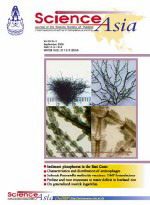ThaiScience
ThaiScience
SCIENCE ASIA
Volume 46, No. 1S, Month MARCH, Year 2020, Pages 85 - 90
Effects of mold sealing and fiber volume fraction on properties of rice strawunsaturated polyester biocomposites
Sakaowduen Preampree, Thanatorn Thanyapanich, Anyaporn Boonmahittsud, Uraiwan Intatha, Nattaya Tawichai, Nattakan Soykeabkaew
Abstract Download PDF
In the past two decades, there has been a huge renewed interest in using natural fibers as reinforcements in composite materials due to growing concerns in the environment and sustainability. Rice straw is one of the agricultural wastes that has a good prospective to be used as a reinforcing agent owing to its abundance in Thailand. In this work, rice straw was used to reinforce with unsaturated polyester (UP) resin and the biocomposites were prepared by using a hot-compression molding technique. With heating involved and monomer loss concerned, firstly, the effect of using two different mold sets; (i) non-sealed mold and (ii) sealed mold during the forming and curing of biocomposites on their structures and mechanical properties was investigated. It was shown that the sealed mold resulted in the higher percentage of gel content or crosslinking degree of the UP matrix as well as an increase in the flexural properties of the biocomposites. This was supposedly due to the ability of the sealed mold to keep the UP system from excessive monomer loss during the heated curing reaction. Secondly, the effect of fiber (rice straw) volume fraction (Vf) on the biocomposite performance was also studied. The results showed that the biocomposites with Vf of 0.3 exhibited the highest strength and modulus values of 29.2 ± 3.3 MPa and 2.3 ± 0.1 GPa, respectively. The SEM photos indicated a relatively good wettability and bonding between rice straw fibers and UP resin in this biocomposite structure.
Keywords
biocomposites, rice straw, unsaturated polyester, processing step, fiber volume fractionSCIENCE ASIA
Published by : The Science Society of Thailand
Contributions welcome at : http://www.scienceasia.org/
